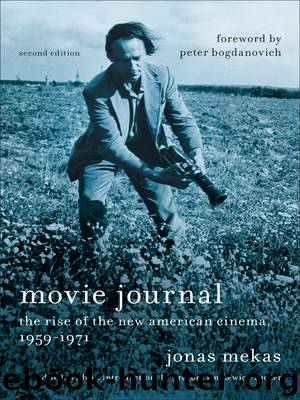Movie Journal by Jonas Mekas

Author:Jonas Mekas
Language: eng
Format: epub
Tags: PER004030, Performing Arts/Film & Video/History & Criticism, LCO010000, Literary Collections/Essays
Publisher: Columbia University Press
Published: 2016-04-18T16:00:00+00:00
ON JERRY JOFFEN AND THE “PERIOD OF EMERGENCE”
Still, there are aspects that remain ungraspable, unfamiliar to the uninitiated. Take, for instance, something that could be called the “period of emergence.” It has become a part of the new art experience and is an essential part of much of the happenings, Beck-Malina theatre, environment, music (sound), and light-motion art. The edges of where a specific work of art begins and where it ends are blurred out. Really, one could say that a happening of Ken Dewey or the cinema of Jerry Joffen or a “ritual” of Angus McLise fades in slowly into the world, is sustained there for a while, glows, and then it dissolves again imperceptibly.
This causes some annoyance and sometimes anger to the uninitiated into the experience and aesthetics (they are always the same but differently dressed up) of the new art. A great part of the audience walked out before Jerry Joffen’s work revealed itself fully; they walked out during the period of emergence, before the work came into its glowing equinox. Being accustomed to traditional (what they think of as traditional) art, the audience was annoyed that there was no immediate art “experience,” no immediate aesthetic shock. Those who remained, however, and surrendered themselves and sat into the evening, witnessed (or grew into) the forty minutes of most beautiful, spiritual, almost heavenly cinema experience. Then, again, it slowly faded out.
This art was born from a new attitude to art; which, in turn, was born from a new attitude to life. We are beginning to meditate. Meditation was out of the Western world for about 1,500 years. It is interesting to note, here, in this context, that when you go to some Chinese or Japanese monasteries, where some of the great works of arts are being kept, you have to go through one week, sometimes longer, periods of preparation, waiting for that specific work of art, learning about it, thinking about it, so that when you finally face it, you are completely ready for it and you see it in its full glow. Its glow is your own glow. That is the direction some of the art in America is taking (it’s the beat revolution that did it).
The first three programs of the New Cinema Festival represent three different and basic groups of artists. Nam June Paik belongs to the purists, to the “intellectual” wing; Angus McLise is the emotion, Jerry Joffen is at home in both. Paik’s program was perfectly designed, constructed, and executed. There was an almost classical simplicity and purity about it. McLise, with all his visual mystico-ornamental flair and the beauty of texture (in image and sound), didn’t seem to be giving much attention either to the general structure or the details of the evening; and his work, despite all-pervading lyrical qualities, had much of the distracting messiness of a dress rehearsal about it. Jerry Joffen, however, has so much personality and artistry that even those parts which failed became somehow integrated and worked perfectly in the total structure of the evening.
Download
This site does not store any files on its server. We only index and link to content provided by other sites. Please contact the content providers to delete copyright contents if any and email us, we'll remove relevant links or contents immediately.
| Diaries & Journals | Essays |
| Letters | Speeches |
The Rules Do Not Apply by Ariel Levy(4863)
Bluets by Maggie Nelson(4477)
Too Much and Not the Mood by Durga Chew-Bose(4277)
Pre-Suasion: A Revolutionary Way to Influence and Persuade by Robert Cialdini(4152)
The Motorcycle Diaries by Ernesto Che Guevara(4016)
Walking by Henry David Thoreau(3897)
Schaum's Quick Guide to Writing Great Short Stories by Margaret Lucke(3322)
What If This Were Enough? by Heather Havrilesky(3275)
The Daily Stoic by Holiday Ryan & Hanselman Stephen(3235)
The Day I Stopped Drinking Milk by Sudha Murty(3159)
The Social Psychology of Inequality by Unknown(2941)
Why I Write by George Orwell(2879)
Letters From a Stoic by Seneca(2738)
A Short History of Nearly Everything by Bryson Bill(2631)
A Burst of Light by Audre Lorde(2548)
Insomniac City by Bill Hayes(2500)
Feel Free by Zadie Smith(2437)
Upstream by Mary Oliver(2346)
Miami by Joan Didion(2324)
